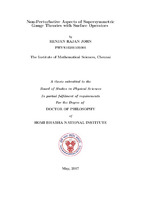- DSpace Home
- →
- IMSc Theses/ Dissertations
- →
- IMSc Theses/ Dissertations
- →
- View Item
JavaScript is disabled for your browser. Some features of this site may not work without it.
| dc.contributor.author | Renjan Rajan John | |
| dc.date.accessioned | 2017-12-11T09:58:30Z | |
| dc.date.available | 2017-12-11T09:58:30Z | |
| dc.date.issued | 2017 | |
| dc.date.submitted | 2017 | |
| dc.identifier.uri | https://dspace.imsc.res.in/xmlui/handle/123456789/411 | |
| dc.description.abstract | In this thesis, we study gauge theories with N = 2 supersymmetry in four dimensions. The low energy effective action of these theories on their Coulomb branch is described by a holomorphic function called the prepotential. In the first half, we study linear conformal quiver theories with gauge group SU(2). These theories have an SU(2) gauge group at each node of the quiver, and matter arranged in the fundamental and the bi-fundamental representations, such that at each node the beta-function vanishes. To compute the prepotential for these theories, we follow three different approaches. These are (i) the classic Seiberg-Witten approach, in which we consider an M-theory construction of the Seiberg-Witten curve and the associated differential, (ii) equivariant localization as developed by Nekrasov, and (iii) the 2d/4d correspondence of the four dimensional gauge theory with the two dimensional Liouville conformal field theory, as put forward by Alday, Gaiotto, and Tachikawa. Matching the prepotential, we find out the precise map between the various parameters that appear in the three descriptions. In the latter half of the thesis, we study surface operators in the context of N=2* theories with gauge group SU(N). These theories describe the dynamics of a vector multiplet, and a massive hypermultiplet in the adjoint representation of the gauge group. Surface operators are non-local operators that have support on a two dimensional sub-manifold of the four dimensional spacetime. They are defined by the singularities they induce in the four-dimensional gauge fields, or can be characterized by the two-dimensional theory they support on their world-volume. The infrared dynamics on the world-volume of the two-dimensional surface operator is described by a holomorphic function called the twisted superpotential. Using localization techniques, we obtain the instanton partition function, and thereby the twisted superpotential of these theories. This involves taking a suitable orbifold of the original action without the surface operator. Imposing constraints from S-duality, we obtain a modular anomaly equation for the coefficients that appear in the mass expansion of the twisted superpotential. Solving the modular anomaly equation at each order, and comparing with the results obtained from localization, we resum the twisted superpotential in a mass series, whose coefficient functions depend on (quasi-) modular forms and elliptic functions of the bare coupling constant and the continuous (complex) parameters that describe the surface operator. We further show that our results for monodromy defects in the four-dimensional theory, match the effective twisted superpotential that describes the infrared properties of certain two dimensional sigma models couples to N=2* gauge theories. This provides strong evidence for the proposed duality between the two descriptions. | en_US |
| dc.publisher.publisher | The Institute of Mathematical Sciences | |
| dc.subject | Supersymmetric Gauge Theories | en_US |
| dc.subject | HBNI Th124 | en_US |
| dc.title | Non-Perturbative aspects of Supersymmetric Gauge Theories with surface operators[HBNI Th124] | en_US |
| dc.type.degree | Ph.D | en_US |
| dc.type.institution | HBNI | en_US |
| dc.description.advisor | Sujay K. Ashok | |
| dc.description.pages | 182p. | en_US |
| dc.type.mainsub | Physics | en_US |
| dc.type.hbnibos | Physical Sciences |
Files in this item
This item appears in the following Collection(s)
-
IMSc Theses/ Dissertations
IMSc Theses/ Dissertations
